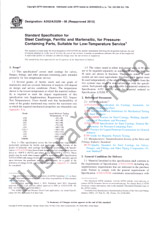Potřebujeme váš souhlas k využití jednotlivých dat, aby se vám mimo jiné mohly ukazovat informace týkající se vašich zájmů. Souhlas udělíte kliknutím na tlačítko „OK“.
ASTM F2997-21
Standard Practice for Quantification of Calcium Deposits in Osteogenic Culture of Progenitor Cells Using Fluorescent Image Analysis
Přeložit název
NORMA vydána dne 15.6.2021
Informace o normě:
Označení normy: ASTM F2997-21
Datum vydání normy: 15.6.2021
Kód zboží: NS-1028686
Počet stran: 17
Přibližná hmotnost: 51 g (0.11 liber)
Země: Americká technická norma
Kategorie: Technické normy ASTM
Kategorie - podobné normy:
Anotace textu normy ASTM F2997-21 :
Keywords:
bone, calcification, image analysis, mineralization, osteoblast, stem cell, tissue engineering, xylenol orange,, ICS Number Code 07.100.10 (Medical microbiology)
Doplňující informace
| Significance and Use | ||||||
|
5.1?In-vitro osteoblast differentiation assays are one approach to screen progenitor stem cells for their capability to become osteoblasts. The extent of calcium deposits or mineralized matrix that form in vitro may be an indicator of differentiation to a functional osteoblast; however, expression of osteogenic genes or proteins is another important measurement to use in conjunction with this assay to determine the presence of an osteoblast. 5.2?This practice provides a technique for staining, imaging, and quantifying the fluorescence intensity and area related to the mineralization in living cell cultures using the non-toxic calcium-chelating dye, XO. The positively stained area of mineralized deposits in cell cultures is an indirect measure of calcium content. It is important to measure the intensity to ensure that the images have not been underexposed or overexposed. Intensity and area do not correlate directly to calcium content. 5.3?XO enables the monitoring of calcium deposits repeatedly throughout the life of the culture without detriment to the culture. There is no interference on subsequent measurements of the mineralized area due to dye accumulation from repeated application (1).3 Calcium deposits that have been previously stained may appear brighter, but this does not impact the area measurement. Calcein dyes may also be used for this purpose (1) but require a different procedure for analysis than XO (that is, concentration and filter sets) and are thus not included here. Alizarin Red and Von Kossa are not suitable for use with this procedure on living cultures since there is no documentation supporting their repeated use in living cultures without deleterious effects. 5.4?The practice may be applied to cultures of any cells capable of producing calcium deposits. It may also be used to document the absence of mineral in cultures where the goal is to avoid mineralization. 5.5?During osteoblast differentiation assays, osteogenic supplements are provided to induce or assist with the differentiation process. If osteogenic supplements are used in excess, a calcium deposit that is not osteoblast-mediated and is referred to as dystrophic, pathologic, or artifactual may occur in the cell cultures 5.6?Due to the possibility of artifactual calcium deposits during mineralization assays 5.7?The deposition of a mineralized substance in the culture dish does not confirm that the cells being cultured are capable of forming bone 5.8?The pattern of mineralized matrix deposition in the culture dish will vary, depending on the number of times the cells have been passaged (that is, first passage primary cells versus cells that have been passaged several times, including cell lines). First passage primary cells typically form relatively large nodules of osteoprogenitor cells that differentiate and mineralize, while cells that have been passaged many times lead to the formation of diffuse, dispersed mineral throughout the culture dish. This practice is independent of the pattern of mineralization and can be used to analyze mineralized matrix in both primary cells and cell lines. 5.9?Since some cells proliferate slower than others and since some of the cell culture surfaces being tested may affect proliferation of the cells, the data can be normalized to total cell number. Since reduced proliferation typically reduces mineralization, normalization to cell number typically does not influence the outcomes. Total DNA content can be determined as an indirect measure of cell number. There are several commercially available kits for this purpose. Since DNA analysis is a destructive, toxic assay, additional cell cultures must be prepared if this assay is used. |
||||||
| 1. Scope | ||||||
|
1.1?This practice defines a method for the estimation of calcium content at multiple time points in living cell cultures that have been cultured under conditions known to promote mineralization. The practice involves applying a fluorescent calcium-chelating dye that binds to the calcium phosphate mineral crystals present in the live cultures followed by image analysis of fluorescence microscopy images of the stained cell cultures. Quantification of the positively stained areas provides a relative measure of the calcium content in the cell culture plate. A precise correlation between the image analysis parameters and calcium content is beyond the scope of this practice. 1.2?Calcium deposition in a secreted matrix is one of several features that characterize bone formation (1.3?The parameters obtained by image analysis are expressed in relative fluorescence units or area percentage (area%), for example, fraction of coverage of the area analyzed. 1.4?UnitsThe values stated in SI units are to be regarded as standard. No other units of measurement are included in this standard. 1.5?This standard does not purport to address all of the safety concerns, if any, associated with its use. It is the responsibility of the user of this standard to establish appropriate safety, health, and environmental practices and determine the applicability of regulatory limitations prior to use. 1.6?This international standard was developed in accordance with internationally recognized principles on standardization established in the Decision on Principles for the Development of International Standards, Guides and Recommendations issued by the World Trade Organization Technical Barriers to Trade (TBT) Committee. |
||||||
| 2. Referenced Documents | ||||||
|




 Cookies
Cookies
